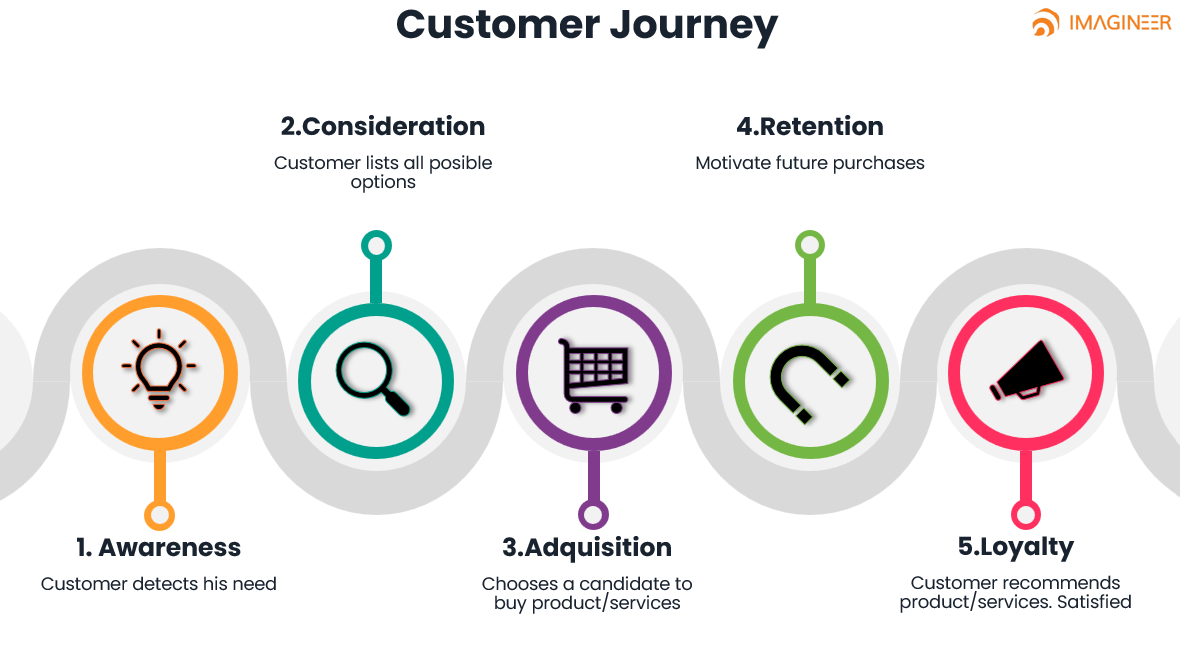Evolution of the retail industry and its processes
By 2022, according to Insider Intelligence in its global e-commerce forecast, "retail sales will grow 5% year-on-year to more than $27.33 trillion."...
Today, organizations are looking for the best channels to communicate with their customers or approach potential customers, establish solid relationships, understand why their customers behave in a certain way and make those decisions when interacting with the product or service provided.
For this, a very valuable tool, the Customer Journey, answers these and other questions. The Customer Journey is the visual representation of the entire experience that the customer has had when interacting with an organization.
By building the Customer Journey, we create more effective business processes, empathize with our customers, and optimize the organization's resources. It guides us and alerts us of the gaps we need to fill in our strategies. Showing promptly to the team where we must improve and reinforce our tasks.
Do you know the stages that are contemplated in a customer journey? I will explain all the relevant information you should consider to get up to speed on this topic as soon as possible.
Index

What is a Customer Journey?
The Customer Journey is a vital part of creating, offering, and delivering better experiences to our customers. It is the journey that the customer takes from the moment the need arises until the acquisition of the product or service. This journey is captured in a map with the stages where the customer interacts with the company to segment efforts according to the consumer's stage.
This information is precious for organizations as it allows them to create strategic marketing plans and, as a result, obtain higher sales.
In other words, the Customer Journey is a method that helps us understand the business from our customer's perspective. So it is crucial not to develop it from the organization's perspective. Just like a map that shows us how to get to a specific destination, this tool shows us the direction to anticipate and know what comes next, what is coming, and what to consider.
This methodology comprises five stages, which I will explain below. Also, for its construction, we must know our buyer persona to trace that path and also consider the following points:
With the help of these questions, we can develop our customer journey through the five stages. With this, we will be able to propose actions for each of them and thus be more assertive in our value propositions when approaching our customers.
Benefits
Among the benefits of creating and having a customer journey, the following points stand out:
The five stages of the Customer Journey
Each aspect of the customer journey corresponds to a different situation through which the customer will pass, such as interest, direct contact with the company, and state of mind. Its duration from one stage to another will be relative as it depends on the industry sector, and the type of product or service to be acquired. The main stages that compose it are:
1. Discovery
It triggers a need on the part of the customer to acquire a product or service, motivated by the work environment and social needs, among other factors. This first phase is intended to inform the person beyond acquiring a product or service. It is announced that something can be beneficial to solve their needs.
2. Consideration
In the search you made, you will have several options to carry out your purchase, and it is where you should know the characteristics of the products or services that our company offers in more detail. As its name indicates, it must consider and keep the company's brand in mind. Our messages to them should be more precise and to the point so that they take us into account.
3. Buy
The option to buy is chosen. The company must offer a unique buying experience, with good customer service, communication, and facilitators of any additional information required. Remove any stopper from the purchase process so as not to complicate the excellent experience that the customer expects to obtain.
4. Retention
Provide an after-sales service where the customer is listened to and satisfaction is maintained. By meeting or exceeding the customer's expectations with our product or service, there is a high probability that they will buy from us again, establishing a bond of loyalty.
5. Loyalty
In this last stage, the customer will be delighted and loyal to the product or service. So much so that they will be more likely to recommend it, give it good ratings, and share its value with others.
Just as a map aims to show us the most critical information in a general and simplified way to move successfully from point A to point B, the customer journey is a tool that shows the data of our customers to know them better, understand them, take care of the relationship established with them and therefore, get to form a close relationship.

If you have any questions or would like to embark on creating a Customer Journey for your company, I invite you to contact the Strategy team, who will be happy to help you.
Visit our website for more information on Customer Journey: https://www.imagineer.co/en-us/consulting-services/marketing-and-sales/customer-journey

By 2022, according to Insider Intelligence in its global e-commerce forecast, "retail sales will grow 5% year-on-year to more than $27.33 trillion."...

Banks face barriers to growth, like market instabilities that increase their operating costs and decrease their profits. Meanwhile, the quality of...

It is no secret that a company's most important resource is its customers; the business's success depends on them, which is why the concept of ...